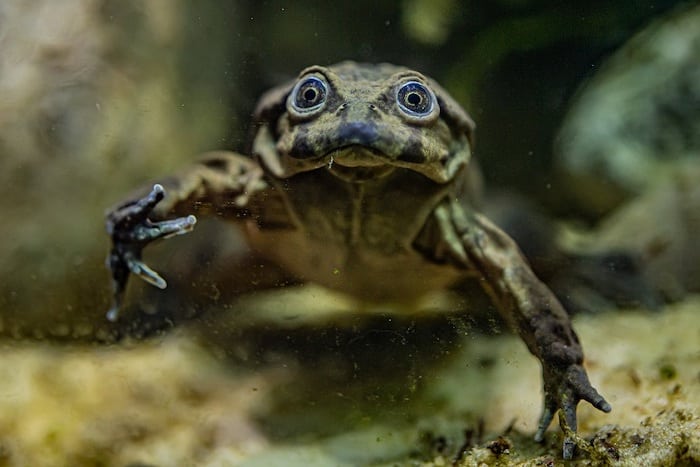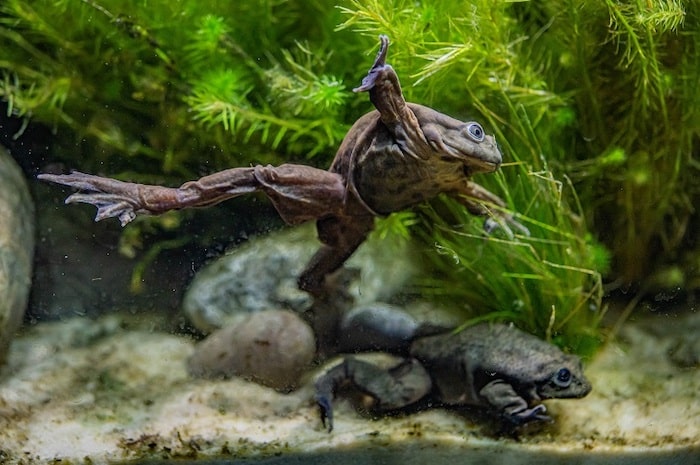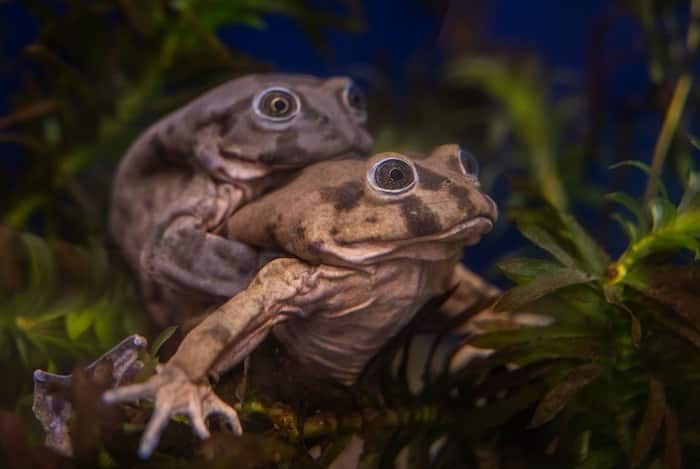Rare ‘scrotum’ frogs on the edge of extinction go on display at Chester Zoo
- Written by Louise Rhind-Tutt
- Last updated 4 years ago
- Attractions, Cheshire

An endangered frog from South America with a rather unfortunate nickname has gone on display at Chester Zoo for the first time.
The Lake Titicaca frog – named after the lake it’s naturally found in which straddles the border of Bolivia and Peru at around 12,500 feet above sea level – is the world’s largest aquatic frog, which can grow up to 20 inches (50cm) long and weigh almost a kilogram.
It spends most its life at the bottom of the lake, absorbing oxygen from the water using its saggy folds of excessive skin – a trait that has seen it labelled the ‘scrotum frog’.

Twenty of the rare amphibians are now being cared for at Chester Zoo, where experts are studying their behaviour to try to gather new insights as part of the latest conservation efforts for the species.
The zoo was the first in Europe to give a home to the species, and has now established a European population by sending 130 other frogs to 13 other leading, progressive zoos around the continent to help prevent total extinction of the frog.
A combination of pollution, habitat loss and hunting has devastated the frog’s wild population. They are listed as endangered by the International Union for the Conservation of Nature (IUCN), with between 50% – 80% estimated as having been lost from Lake Titicaca in the last 20 years alone.
In response, nearby researchers set up a rescue centre and began attempts to breed the frogs, before seeking assistance from conservationists at Denver Zoo in America and now, Chester Zoo in the UK.

Meanwhile, Chester Zoo has also formed an alliance with the Cayetano Heredia University in Peru and the Natural History Museum’s Alcide d’Orbigny in Bolivia in a ground-breaking union which is fighting to save the Lake Titicaca frog from extinction.
The two South American institutions are part of a binational action plan for the conservation of the species – the first time the two countries have come together to attempt to protect the frogs.
The plan of the two organisations is focused on securing the future of the lake by promoting sustainable activities for local communities, recovering the habitat and managing the wild frog population.
“To be responsible for setting up the first ever conservation breeding programme in Europe for these fascinating frogs is a real honour for us here at Chester Zoo,” said Dr Gerardo Garcia, the zoo’s Curator of Lower Vertebrates and Invertebrates.
“We’re very happy that we can now share our efforts to protect these frogs with the wider public, who will most likely be seeing them for the very first time during their visit the zoo.
“What we need to do now is to build on our knowledge of the species and its biology – by learning all about their life cycle, mating behaviours, favoured habitat and ability to tolerate or resist a deadly fungus that is wiping out lots of amphibians, called chytrid.
“We can then harness that valuable information for conservation action in the wild.

“These frogs are also important ambassadors for their species and will help us to raise more awareness of their plight in the wild.
“Lake Titicaca frogs are highly threatened with extinction. The one, high montane lake that they live in is an extremely fragile environment and they have really suffered at the hands of pollution and introduced fish species.
“It’s illegal to harvest these frogs but Peruvian and Bolivian locals are still known to do so – they use them in smoothies, which they believe enhances virility and energy.
“The planet is facing its biggest ever biodiversity extinction, with thousands of amphibian species at risk of being lost forever.
“Human activity is very much part of the problem, but we won’t sit back and let them become extinct because we’re also key to the solutions and will play a vital role in reversing the damage.
“We want to make sure the Lake Titicaca frog is around for generations to come.”
- This article was last updated 4 years ago.
- It was first published on 25 August 2021 and is subject to be updated from time to time. Please refresh or return to see the latest version.
Did we miss something? Let us know: press@ilovemanchester.com
Want to be the first to receive all the latest news stories, what’s on and events from the heart of Manchester? Sign up here.
Manchester is a successful city, but many people suffer. I Love Manchester helps raise awareness and funds to help improve the lives and prospects of people across Greater Manchester – and we can’t do it without your help. So please support us with what you can so we can continue to spread the love. Thank you in advance!
An email you’ll love. Subscribe to our newsletter to get the latest news stories delivered direct to your inbox.
Got a story worth sharing?
What’s the story? We are all ears when it comes to positive news and inspiring stories. You can send story ideas to press@ilovemanchester.com
While we can’t guarantee to publish everything, we will always consider any enquiry or idea that promotes:
- Independent new openings
- Human interest
- Not-for-profit organisations
- Community Interest Companies (CiCs) and projects
- Charities and charitable initiatives
- Affordability and offers saving people over 20%
For anything else, don’t hesitate to get in touch with us about advertorials (from £350+VAT) and advertising opportunities: advertise@ilovemanchester.com


The Manc aerobics queen who trained the Corrie cast is helping raise charity cash

Ancoats to get even cooler as independent market set for MOT garage site

“Manchester is not Britain’s second city, it’s the first” – Jeremy Clarkson
















